Corzetti: The Intagliatore of Chiavari

This is Part 2 of a series – The Corzetti Files
For detailed information and photo essays on how to make corzetti, along with recipes, please delve further into The Corzetti Files:
Edible Art, The Corzetti Files – Part 1
The Intagliatore of Chiavari, The Corzetti Files – Part 2
Corzetti agli Spinaci con Gorgonzola, The Corzetti Files – Part 3
Where to Buy Corzetti Stamps, The Corzetti Files – Part 4
Corzetti Stampati – and a Giveaway! The Corzetti Files – Part 5
A Gold Coin
 The pasta we know as Corzetti started with a gold coin, the Genovino d’oro. Rome had fallen, and the curtain of The Dark Ages had descended over western Europe. Trade has fueled society for centuries, and it is trade that brought gold coins and light back to western Europe. The gold came across the Sahara from north Africa and Genoa’s harbor assured her of preeminent mercantile stature. King Conrad granted Genoa the right to mint her own gold coinage in 1252, and these pieces of almost pure gold summon up the history and wealth of The Most Serene Republic of Genoa.
The pasta we know as Corzetti started with a gold coin, the Genovino d’oro. Rome had fallen, and the curtain of The Dark Ages had descended over western Europe. Trade has fueled society for centuries, and it is trade that brought gold coins and light back to western Europe. The gold came across the Sahara from north Africa and Genoa’s harbor assured her of preeminent mercantile stature. King Conrad granted Genoa the right to mint her own gold coinage in 1252, and these pieces of almost pure gold summon up the history and wealth of The Most Serene Republic of Genoa.
 Coming in at about 3.5 grams, the earliest of these coins feature the city gate and to honor King Conrad and his participation in the Crusades, a Crusader cross on the reverse. The coins are covered with a beautiful relief. One of the most famous coins honors the first Doge of Genoa, Simone Boccanegra, and later coins honor subsequent families and Doges. Today one must visit a museum or be fortunate enough to know a collector to view these coins, but with Liguria’s gift to the world of the pasta known as corzetti stampati (kohr-TSEHT-tee stahm-PAH-tee), the legacy of these glorious coins is alive and well and available to us all.
Coming in at about 3.5 grams, the earliest of these coins feature the city gate and to honor King Conrad and his participation in the Crusades, a Crusader cross on the reverse. The coins are covered with a beautiful relief. One of the most famous coins honors the first Doge of Genoa, Simone Boccanegra, and later coins honor subsequent families and Doges. Today one must visit a museum or be fortunate enough to know a collector to view these coins, but with Liguria’s gift to the world of the pasta known as corzetti stampati (kohr-TSEHT-tee stahm-PAH-tee), the legacy of these glorious coins is alive and well and available to us all.
A Piece of Wood
I have an ongoing love affair with handmade pasta, and this one captivated me from the start. Imagine my delight when I discovered its history, how it was made, and that I could do it at home. All I needed was a corzetti stamp, the two piece tool that cuts and imprints the pasta. By the way, you may come across pasta in shops, in recipes or on menus called croxetti, crosetti or curzetti – these are all names for corzetti.
Originally designed to mimic gold coins from the glory days of Genoa, today’s stamps are often carved with coats of arms, palm trees, flowers, sheaves of wheat and various custom designs. Although factory-made mass produced stamps are available for purchase, they lack the warmth, originality and character of hand carved custom ones. For something unique I knew I would need to venture into the realm of the intagliatore – the wood carver.
The Intagliatore of Chiavari
 Signore Franco Casoni works in the historic section of Chiavari, near Genoa. Maestro intagliatore, artist and gentleman, Sig. Casoni began his training with a sculptor at the age of thirteen, went on to art school, and has been working with wood his entire life. His oeuvre is comprised of much more than these beautiful stamps; he has created and restored church sculpture in many Italian cities, collaborated with other artists, carved statues, public monuments and more. Continuing the finest tradition of Genoese ship building he carves the most spectacular polene (figureheads) for ships. Yes, those magical figures, the mermaids and beautiful women who grace the prows of ships are still made today. And Sig. Casoni is a master. To experience his genius, go to his web site, and view images of his work. Prepare to be awed. I ordered a stamp that celebrates not only his skill, but the legacy of the Republic of Genoa, the culinary arts and my family heritage.
Signore Franco Casoni works in the historic section of Chiavari, near Genoa. Maestro intagliatore, artist and gentleman, Sig. Casoni began his training with a sculptor at the age of thirteen, went on to art school, and has been working with wood his entire life. His oeuvre is comprised of much more than these beautiful stamps; he has created and restored church sculpture in many Italian cities, collaborated with other artists, carved statues, public monuments and more. Continuing the finest tradition of Genoese ship building he carves the most spectacular polene (figureheads) for ships. Yes, those magical figures, the mermaids and beautiful women who grace the prows of ships are still made today. And Sig. Casoni is a master. To experience his genius, go to his web site, and view images of his work. Prepare to be awed. I ordered a stamp that celebrates not only his skill, but the legacy of the Republic of Genoa, the culinary arts and my family heritage.
He carved my family name, Crocetti, along the border of one side of my stamp, and decorated both sides with Christian crosses of varying sizes. He also carved another stamping piece with a lovely traditional motif. More than a kitchen tool, it is a link to my family’s past, and I thank Sig. Casoni for his help in forging the chain.
A Mound of Flour
Corzetti stampati, an egg pasta, can be made with white, whole wheat, chestnut and even buckwheat flours. Many recipes call for the addition of Parmigiano, chopped fresh herbs or even wine, such as Vermentino or Pigato.
The two piece stamps are ingenious and very simple to use.
In two steps you cut and emboss the pasta. At the end of one piece is a circular cutter. Designs are carved into the top of the cutting piece and the bottom of the second piece.
After the round of pasta is cut, it is placed between the two carved parts of the stamp, which are pressed firmly together and then separated – behold a pasta disc in high relief.
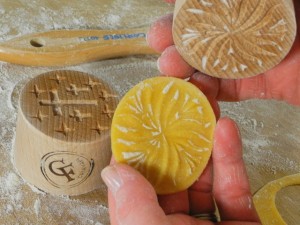
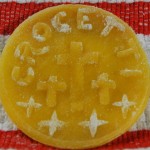 For a step by step photoessay on how to form and cut corzetti, click here to see my Corzetti Part 1 article. The raised design is not only decorative – it is functional as well; the design serves to hold the condimento making sure the diner gets a tasty mouthful with every bite. Sig. Casoni carves his stamps from beech. He told me that in years past Italian carvers used apple, pear and cherry woods, however he now uses beech exclusively. A neutral wood, it does not perfume the pasta. The unfinished beech has another advantage. Just as the surface of pasta has more texture if rolled with a wooden matterello (rolling pin) on a spianatoia (wooden board), the use of an unfinished wooden stamp has the same effect. Compare pasta rolled with a plastic or metal machine to pasta rolled on wood, and you will discover what I am talking about. The texture of the wood transfers to the pasta. Pasta rolled in this manner holds the condimento better and has a more pleasing mouthfeel. Sig. Casoni also offered a few words on the care of his stamps. His suggestion: it is best to brush it off after use, rather than washing it.
For a step by step photoessay on how to form and cut corzetti, click here to see my Corzetti Part 1 article. The raised design is not only decorative – it is functional as well; the design serves to hold the condimento making sure the diner gets a tasty mouthful with every bite. Sig. Casoni carves his stamps from beech. He told me that in years past Italian carvers used apple, pear and cherry woods, however he now uses beech exclusively. A neutral wood, it does not perfume the pasta. The unfinished beech has another advantage. Just as the surface of pasta has more texture if rolled with a wooden matterello (rolling pin) on a spianatoia (wooden board), the use of an unfinished wooden stamp has the same effect. Compare pasta rolled with a plastic or metal machine to pasta rolled on wood, and you will discover what I am talking about. The texture of the wood transfers to the pasta. Pasta rolled in this manner holds the condimento better and has a more pleasing mouthfeel. Sig. Casoni also offered a few words on the care of his stamps. His suggestion: it is best to brush it off after use, rather than washing it.

Sig. Casoni may be contacted at:
Franco Casoni
Via Bighetti 73
16043 Chiavari Genoa
Liguria Italia
In the Kitchen
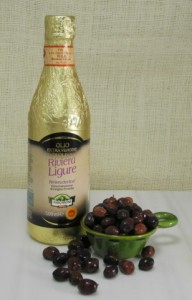 The unique geography of Liguria and her temperate climate combine to offer up wonderful fruits and vegetables and a profusion of herbs infused with the briny essence of the sea. Her bounty offers unmatched possibilities for grande cuisine and simple pasta dishes. And Liguria’s fertile ground gives forth an unmatched treasure, the Taggiasca olive.
The unique geography of Liguria and her temperate climate combine to offer up wonderful fruits and vegetables and a profusion of herbs infused with the briny essence of the sea. Her bounty offers unmatched possibilities for grande cuisine and simple pasta dishes. And Liguria’s fertile ground gives forth an unmatched treasure, the Taggiasca olive.
It is the Taggiasca olive that goes into the making of my favorite imported olive oil, the lightly fragrant Riviera dei Fiori. This very delicate oil is a perfect match for corzetti, a very elegant pasta. Farchioni and Barilla are two of my favorite brands. Let your imagination guide you in your choice of condimenti. There is no end to what you can do. Here are a few suggestions.
![]()
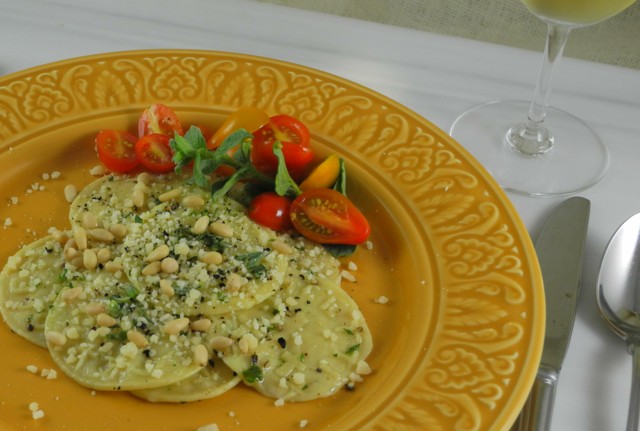
Corzetti Stampati alla Maggiorana
Classic. Pure. Feel free to adjust the amounts I give, most especially because this member of the mint family with its lemon and pine notes is an herb of which we Americans make woefully little use. Experiment and add it to your own taste, (q.b.) and I bet that over time you will grow to love it and find yourself using more and more. Speaking of growing, plant this perennial in your garden. It makes a gorgeous and vibrant border, takes care of itself and will quickly spread and widen, while keeping its low habit. It can be sensitive to frost, but for us here in temperate southern California, marjoram is a garden stalwart.
for a first course for 2 people
1/4 pound corzetti
olive oil to coat
2-3 teaspoons chopped fresh marjoram q.b.
pignoli
cracked black pepper
grated Parmigiano-Reggiano
Make this recipe your own. Have fun in your kitchen and learn to cook by looking and smelling. Be flexible. No olive oil? Use unsalted butter instead. No fresh marjoram? Use dried, or another herb altogether. No pignoli? Grab some walnuts. Or a handful of almonds. If it’s summer, toss in a few chopped tomatoes. When the pasta is done, transfer to a large bowl, add enough oil to coat, and enough chopped marjoram and black pepper to fill your senses. Give your hoard of pasta coins a very gentle toss to combine. Slide the pasta onto plates, top with Parmigiano-Reggiano and a handful of pignoli.
![]()
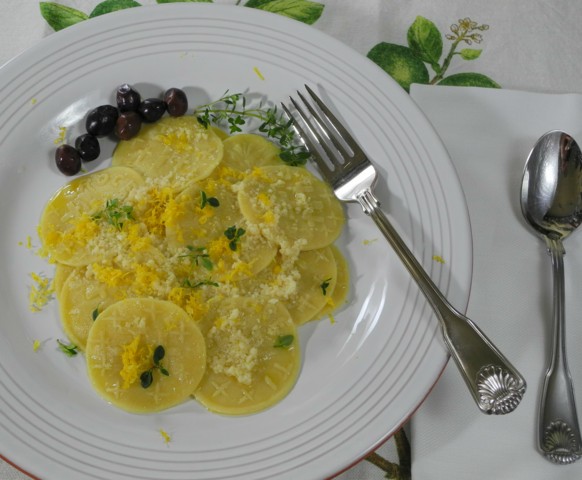
Corzetti Stampati al Limone
This is a surprisingly bright pasta, with a taste that evokes the Italian sun. Pure lemon is the predominant flavor, and depending on your lemons you may have to adjust the ingredients. Should you be fortunate enough to have an Italian lemon tree, such as Sorrento, Femminello Santa Teresa, Genoa, Villafranca or Costa d’Amalfi, you are halfway there. For years American gardeners and cooks searched in vain for Italian lemon trees. They were until recently all but impossible to find. However, nurserymen are always attuned to culinary trends, and Four Winds Growers and Bay Flora now offer Italian lemon trees. Growers are at work year round developing new trees for their customers, and it won’t be long before these trees will be as easy to find as Eureka and Meyer lemons. While we in the U.S. can never replicate the growing conditions native to these plants, most especially the calcareous soil and sea air, the trees themselves and the fruit they bear bring us a step closer to Italy.
for a refreshing first course for four
half recipe of plain corzetti
1/2 cup olive oil
1/2 cup grated Parmigiano, and more at the table
juice of 2 to 3 lemons
3 to 4 tablespoons chopped herbs – such a lemon thyme, Italian parsley and basil
1 tablespoon lemon zest
Combine oil, Parmigiano and lemon juice, starting with juice of 2 lemons, in warm pasta bowl. Taste for balance, adding more oil or lemon juice if desired. Add pasta and toss to coat. Add a few tablespoons of pasta water to loosen sauce if necessary. Add salt and black pepper and taste again. Depending on your lemons, you may have to add more juice or more oil. Toss with herbs and top with lemon zest. Serve with additional Parmigiano and herbs.
![]()
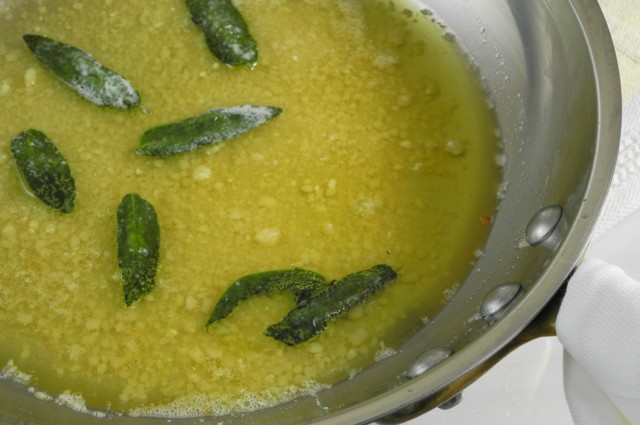
Corzetti Stampati with Butter and Sage
This is about as simple and classic as it gets. The goal here is to cook the sage slightly without browning the butter. Should you brown the butter, that is fine, you will just have a different dish. And if indeed your goal is to brown the butter, watch my video to learn how.
for a first course for four
half recipe of plain corzetti
1/4 pound unsalted butter
6-10 sage leaves, q.b.
4 tablespoons Parmigiano, plus more at the table
Melt butter in medium frypan. Drop sage leaves in hot butter and fry gently until the edges curl a bit and they become fragrant. Remove frypan from heat and stir in Parmigiano. Add corzetti along with 2 or 3 tablespoons of pasta water to loosen sauce. Toss to coat. Slide onto plates, crack a bit of black pepper over each and serve with additional Parmigiano.
![]()

Corzetti with Walnut Sauce
a first course for four to six
full recipe of corzetti
1 cup walnuts
1 tablespoon plain bread dry bread crumbs
1 small clove garlic
1/4 teaspoon sea salt
2 tablespoons Parmigiano, plus more at the table
1/2 to 1 teaspoon minced fresh marjoram, plus more for garnish
1/2 cup mascarpone or creme fraiche
2 tablespoons olive oil
Fit food processor with steel knife and process walnuts, bread crumbs, garlic and salt into a paste, stopping to scrape down sides 2 or 3 times. Transfer mixture to a bowl and add Parmigiano and marjoram, mixing well. Add mascarpone or creme fraiche. Blend thoroughly. Add olive oil, blending well. Serve over pasta with additional marjoram and cheese.
How to Make Corzetti
Corzetti Dough
Here are two recipes for pasta dough. These recipes call for doppio zero flour, a finely milled Italian flour available in many Italian markets and on Amazon. If you do not have 00 flour, you will still achieve terrific results with all-purpose flour. For more on doppio zero flour, see my post on Crostoli.
Al Limone and Butter and Sage condimenti partner best with Dough #1, while the others marry very nicely with either Doughs #1 or #2.
A note about corzetti dough – resist the urge to make a very soft dough. Although it will be an absolute pleasure to knead and stamp, the relief will not hold its integrity and will recede into the dough. Should this happen, all is not lost. You can re-stamp each pasta disc once they have dried a bit, with no great loss in texture.
Dough#1
2 cups 00 or all-purpose flour
2 large eggs plus one large egg yolk
2 tablespoons olive oil
a bit of water, if necessary
extra flour for the board and towels
Dough #2
2 1/4 to 2 1/2 cups 00 or all-purpose flour
2 large eggs
1 tablespoon olive oil
1/4 cup Vermentino wine
2 teaspoons minced fresh marjoram
extra flour for board and towels
Method 1:
Place flour on work surface. Make a fontana (well) in the center by hollowing out a spot about the size of an orange. Place eggs and olive oil (and marjoram and 2 tablespoons Vermentino if you are making dough #2) in the fontana. Using a fork, agitate to mix. With each stroke of the fork, bring a bit of flour into the mix, being careful to maintain the integrity of the outer walls of the flour by moving your free hand around the outside of it and shoring up the sides until all the flour is mixed with the eggs and olive oil. You may have to add more flour if the dough is too wet or a bit of water (or wine) if it is too dry. Once the flour is incorporated and the dough has come together in a shaggy mass, gather it and set aside. Using a bench scraper, clean work surface. Scatter just a bit of flour over the work surface and return dough. Knead for about 5 minutes, until it is smooth, elastic and just barely sticky. Wrap dough in plastic and allow it to rest 30 minutes.
Method 2:
Place flour (and marjoram if you are making dough #2) in workbowl of food processor fitted with steel blade. Place eggs and olive oil (and 2 tablespoons wine if you are making dough #2) in a measuring cup and use a fork to lightly mix. With processor running, add egg mixture in a steady stream until dough comes together, about 30 seconds. Check to see if dough is too wet or too dry, adding flour or water or wine, as needed. Remove dough from processor and knead about 1 minute. Wrap in plastic and allow it to rest 30 minutes.
Rolling Corzetti
Cut dough into 4 pieces. Keep the pieces you are not working with wrapped in plastic. Flour work surface, and working with one piece at a time roll dough to about 1/16 of an inch using a rolling pin or pasta machine. I can not tell you exactly which level to roll to with a pasta machine as there are variations between machines. I usually go to the second to the last on my 35 year old Atlas. Roll the dough too thinly and the imprint from one side will show through to the other. Roll it too thickly and you will lose the delicacy so integral to this pasta. Experiment and let your eyes and mouth guide you. You will quickly settle on the particulars.
Stamping Corzetti
Lightly flour corzetti stamp. Use the circular cutting edge to cut round pasta “coins.” Place the round of pasta between the two carved parts of the stamp and press firmly. Separate the two pieces, and behold – a pasta disc in high relief. Place the corzetti on towel lined trays sprinkled with flour. Cover the corzetti with a clean dry towel as you work. For more recipes and a step by step photoessay on how to form and cut corzetti, click here to see Corzetti Part 1.
Cooking Corzetti
There is no salt in this dough, so you must liberally salt the water. On this point all nonne are in agreement – “The water must taste like the Mediterranean.” Add a handful of coarse sea salt after water has come to a lively boil. Cook in abundantly salted water until done, about 3 to 4 minutes for fresh pasta.
Note: You can click on any picture to see a slide show with even more pictures!
I have no affiliation with any product, manufacturer, or site mentioned in this article.
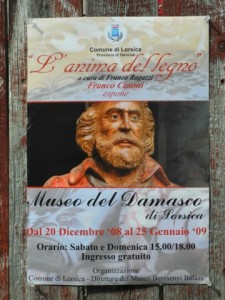

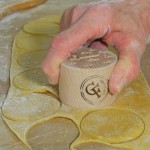

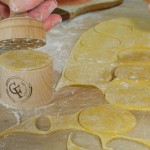
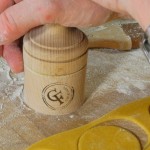
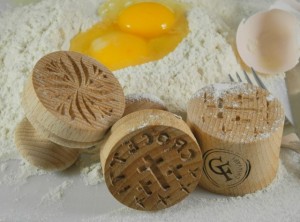





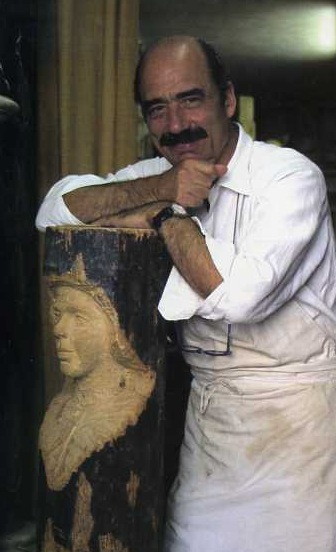

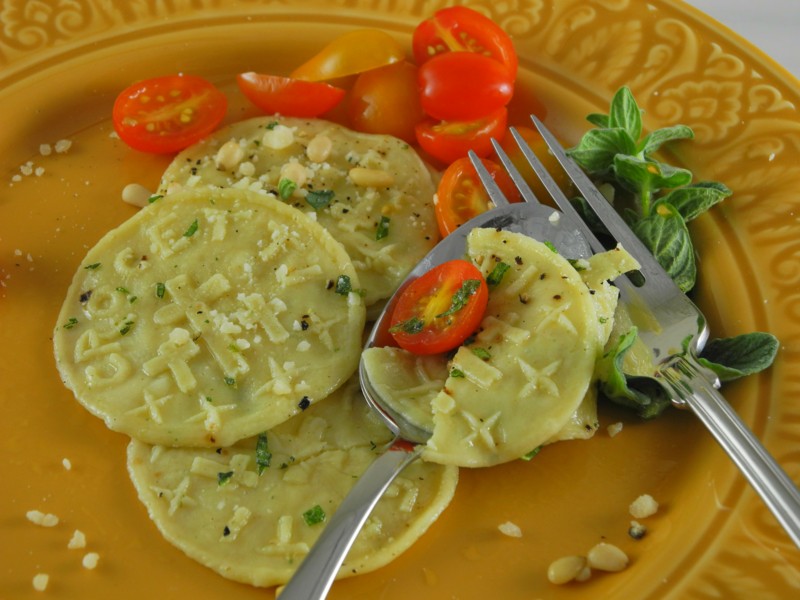




Tuesday, April 26th 2011 at 10:55 am |
This is so cool! I always love sage butter…and I’m really interested in trying that marjoram-flavored pasta dough. Thanks for the recipes and the history!
Tuesday, April 26th 2011 at 2:23 pm |
I’m glad you enjoyed the post. I loved working with the dough- it smelled great. When you make it, send me a shot for Readers Gallery. I’d love to display your work. Any questions – feel free to email.
Tuesday, May 3rd 2011 at 11:32 pm |
nice post. thanks.
Tuesday, June 28th 2011 at 3:08 am |
Beautiful post! I am glad I have found somebody else who went out of their way to get these molds and make this delicacy. Tradition shall continue!
Tuesday, June 28th 2011 at 6:56 am |
Viva la tradizione!